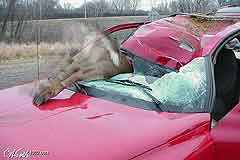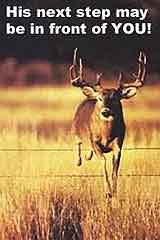Every year there are about a million-and-a-half collisions between vehicles and deer in the U.S. These result in about 150 fatalities and over a billion dollars in vehicle damage. At least 1.5-million deer are also killed.

Awhile back I was one of these statistics. I was driving late at night on an open stretch of I-25 in Colorado when a deer suddenly appeared in my headlights. There was no chance to stop, or even apply brakes. I hit the deer at 70 mph! Fortunately, I wasn’t injured, but my BMW incurred over $7,000 in damage. I was very lucky since the deer went under the car rather than over it, the more typical occurrence.
According to State Farm, the following states had the highest number of accidents involving deer between July 1, 2004 and June 30, 2005:
- Pennsylvania
- Michigan
- Illinois
- Ohio
- Georgia
- Minnesota
- Virginia
- Indiana
- Texas
- Wisconsin

The chances of hitting is growing greater since the deer population is growing exponentially across the country. According to National Highway Traffic Safety Administration (NHTSA) vehicle-animal collisions rose 24 percent in 2000-01 compared to 1992-93. Urban sprawl that displaces deer to crowded areas and busy roads compounds the problem. Two-thirds of all incidents occur in the fall when deer migrate and mate. The shorter days and limited nighttime visibility also contribute to the problem.
State Farm gives some tips to avoid a car-deer collision, as well as how to survive one if a deer hit cannot be avoided.
- Remain aware of posted deer crossing signs. These signs are placed in known active deer crossing areas.
- Be aware that deer are most active during the early evening.
- At night, use high-beam headlamps as much as possible to illuminate the sides of the road where deer can linger.
- Be aware that deer often move in packs -- if you see one deer, there is a good chance several more are just a few yards behind.
- Do not rely on car-mounted "deer whistles." Studies have shown deer are not affected by this deterrence method.
- If a collision with a deer seems inevitable, it may be best not to swerve, but to hit the deer straight on The risk of personal injury is greatly increased by swerving which can place you in the path of oncoming vehicles or may cause you to lose control of your vehicle and result in hitting another vehicle or some obstacle.
While fences might cut down on car-deer collision, it only reduces the problem somewhat. The deer I hit had just jumped the six-foot tall “limited access” fence. The best way to avoid car-deer collisions is through attentive driving, and slowing down, in deer country.




